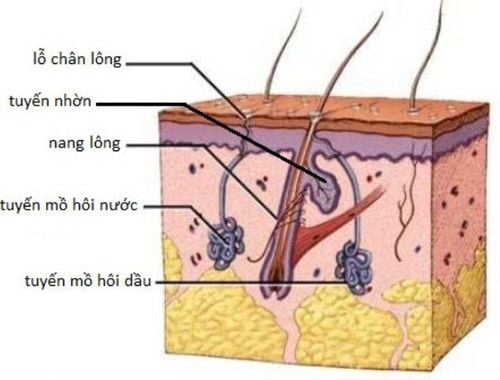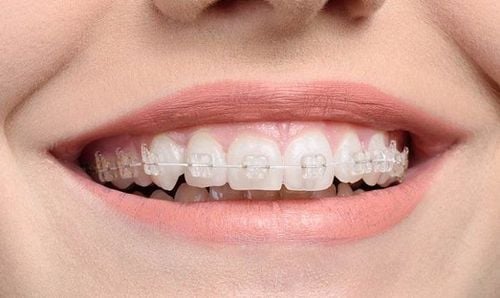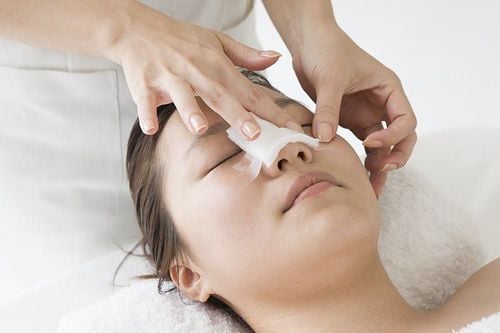This is an automatically translated article.
Sweat glands appear all over the body, but are most abundant in the forehead, armpits, palms, and legs. When an increase in temperature is detected, sweat is released to cool the skin and lower the internal body temperature. Therefore, sweat glands under the skin are essential in keeping the body temperature stable.
1. Structure of sweat glands under the skin
Sweat glands have a coiled tubular structure, which is important for regulating human body temperature. There are 2 different types of sweat glands, including eccrine and apocrine. In which:
The eccrine gland occurs mostly in the body and opens directly on the surface of the skin. Apocrine glands secrete mucus containing lipids, proteins and steroids through hair follicles in the scalp, armpits, and groin. The apocrine glands often appear to respond to emotional stimuli, including anxiety and fear, with, for example, sweating in the palms, feet, and armpits. Sweat is a dilute electrolyte solution consisting of 99% water, sodium chloride, potassium, bicarbonate, calcium, magnesium, lactate, ammonia, and urea. The sweat glands consist of an acinar-secreting structure coiled in the dermis and a straight duct that connects this acinar structure to the surface of the epidermis.
2. Function of the sweat glands under the skin
The main function of sweat glands is to keep body temperature around 37°C. To maintain body temperature, the body will sweat in hot environments or during physical activity. As the water in sweat evaporates, the surface of the skin cools.
Sweating is controlled by the central nervous system. Thermal neurons in the brain can detect internal and external body temperature, instructing sweat glands to respond appropriately to maintain a constant body temperature.
When an increase in temperature is detected, sweat is released to cool the skin and internal body temperature. Therefore, sweat glands are essential in keeping the body temperature constant.
If our body temperature gets higher than 40°C, it can lead to protein denaturation and apoptosis. Physically, it will lead to hyperthermia, commonly known as heatstroke, which can even be fatal.

Chức năng chính của tuyến mồ hôi dưới da là giữ cho nhiệt độ cơ thể ở mức khoảng 37°C.
3. Some diseases related to sweat glands
Sweating is considered normal when living in high temperature environments, such as in the summer; physical activity, exercise; stress, anxiety, fear; eat spicy or hot foods; have a high fever. However, in some cases, sweat glands can cause medical conditions such as:
Dyshidrosis. This condition can lead to dehydration or anhidrosis, leading to fatigue, weakness, dizziness, and shortness of breath.
Hyperhidrosis Excessive sweating is called hyperhidrosis. Idiopathic hyperhidrosis is the most common form. Called idiopathic because no cause can be found, it can develop in childhood or later in life.
People with this condition can sweat profusely even in cool weather, but it gets worse when the weather is warm and emotionally stressful. There are many causes of increased sweating such as obesity, hormonal changes, hyperthyroidism, diabetes or taking certain medications.
The treatment of increased sweating depends on the cause, for example, obese people need to lose weight appropriately. Some cases require topical medications (antiperspirants with 10–25% aluminum salts, anticholinergics) or hormone replacement therapy, surgery of the nerves that control sweat glands under the skin.
In particular, to avoid more serious sweating, the patient should wear loose-fitting clothes and use products that prevent perspiration.
Decreased sweating (hypohidrosis) Decreased sweating when the body secretes very little or even does not appear despite high ambient temperature, vigorous exercise... Causes of decreased sweating can occur because There are a number of reasons such as skin disorders, burns that damage sweat glands, hypothyroidism, dehydration or prolonged excessive heat.
In summary, sweat glands under the skin have an important role in maintaining body temperature. Increased or decreased sweating can cause life-threatening temperature control problems. Therefore, as soon as you notice abnormal signs of sweat glands, you should go to a medical facility for examination and appropriate treatment.
Please dial HOTLINE for more information or register for an appointment HERE. Download MyVinmec app to make appointments faster and to manage your bookings easily.
References: Betterhealth.vic.gov.au, Mayoclinic.org, Sciencedirect.com













